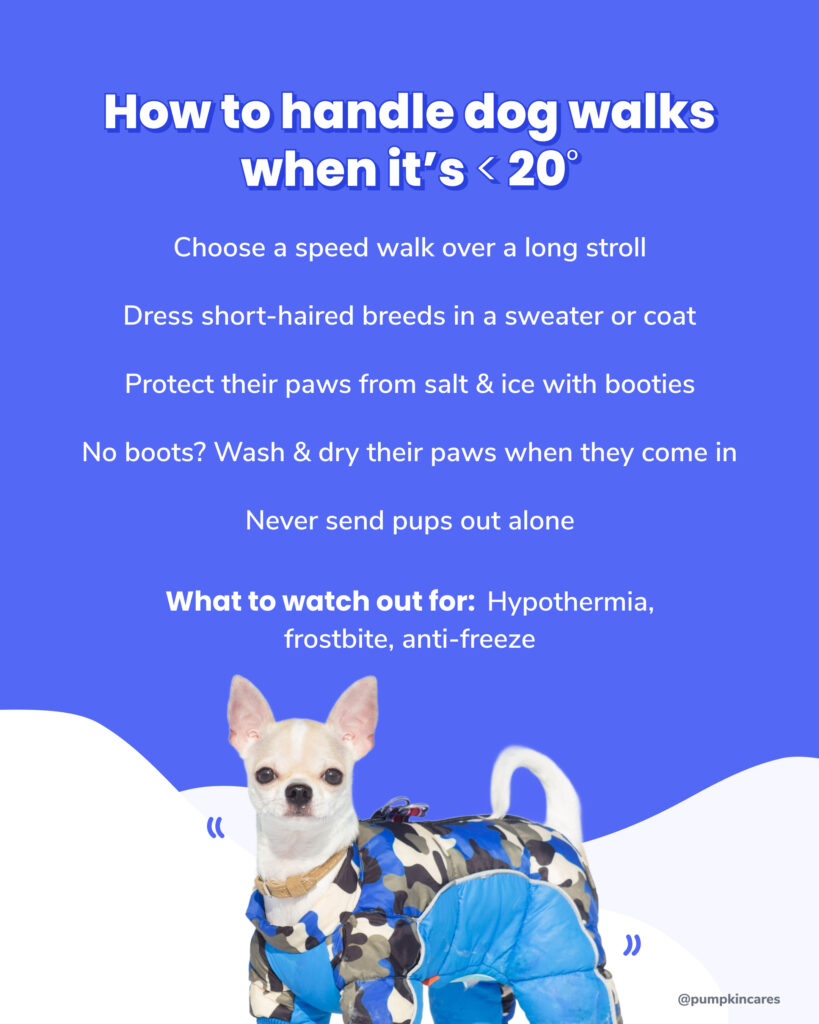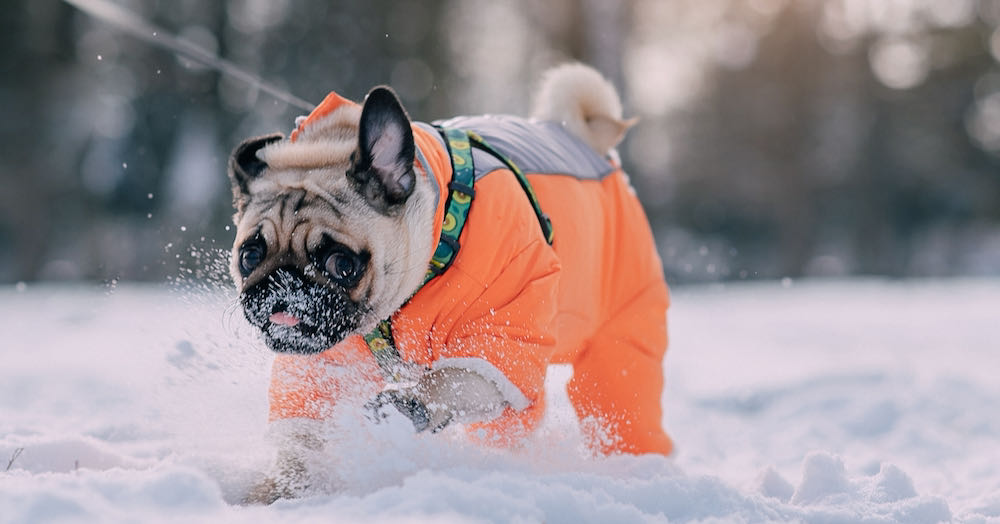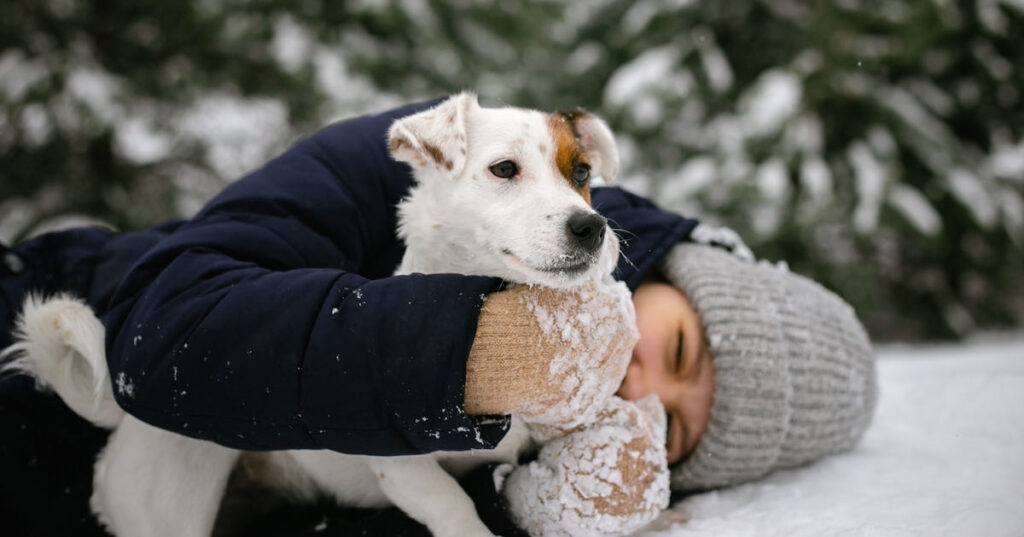Outdoor exercise is great for your pets, especially if you have a high-energy breed that needs a lot of exercise. So far so good, but what about when temperatures plunge in the winter? Should your pup still spend time outside when you’re in the middle of a record-breaking cold snap?
It can be difficult to tell when it’s too cold for your dog or cat to be outside. While we bundle up in coats, scarves, and mittens, our pets might not always have the protection they need. Here are some general rules to follow to keep your dog and cat safe when the temperature drops below freezing — or way below freezing. We’ll also debunk some common myths about pets and winter safety.
How cold is too cold for dogs?
When it comes to cold weather, how cold is too cold for your dog? The answer depends on a few factors, like their breed, size, and age. However, in general, when the temperature drops below 32° Fahrenheit (0° Celsius), it’s too chilly for most dogs. Does that mean your dog can’t go outside at all? Of course not, but you should take extra precautions and watch for signs that your chilly pup needs to come inside.

Small dogs, those with short fur, or older dogs are especially sensitive and can get cold faster. If a dog spends too much time outside in freezing temperatures, they could suffer from frostbite or hypothermia. Watch for signs like shivering, acting tired, or not wanting to move — these can be signs that your dog is too cold. To keep them safe, it’s a good idea to limit outdoor time in cold weather and provide extra warmth, like dog coats or blankets.
There are exceptions, however. So, before you call animal control on your neighbors who left their dog outside in the snow, remember that some pups thrive in cold weather. Snow-loving breeds like Huskies and Bernese Mountain Dogs were literally made to spend time in the cold, and they have long, thick coats that keep them warm in freezing temperatures. Still, even though many stubborn Huskies will try to spend every possible second outside, it’s important to watch out for the warning signs of hypothermia.
How cold is too cold for cats?
Cold temperatures are also a concern for cats, especially outdoor cats. Our kitties are pretty good at handling winter weather, but they can still get too cold when it drops below freezing. If they don’t have a warm place to nest or are exposed to the elements for too long, outdoor cats can face fatal consequences. Cats with short fur, kittens, older cats, or cats with health issues are more likely to be affected by the cold.
If your outdoor cat starts shivering, acting lethargic, or trying to find warmer places, they might be too cold. To help them stay safe, provide a sheltered spot, like a heated cat house or a warm blanket in a dry area. During really cold weather, it’s a good idea to bring them inside when possible.
In addition to these general guidelines, you might hear a lot of different information about what is and isn’t safe for your pets in cold weather. Unfortunately, there are a lot of myths about pets and winter safety that can put them at risk. Let’s debunk some of the most common misconceptions and keep your pets safe and warm this winter.
1. “My pet’s fur keeps them warm enough in the cold.”
Myth: Many pet owners believe that if a dog or cat has a thick coat of fur, they’ll be fine in the cold weather. However, even pets with dense coats can suffer from the dangers of winter weather.
Fact: Fur may provide some insulation, but it’s not foolproof. Dogs and cats still get cold, especially if they’re outside for extended periods. Certain breeds are more vulnerable to the cold, such as short-haired dogs or small breeds. Added dangers such as wind and wet conditions can heighten the risks of hypothermia and frostbite, even for pets with thicker coats. Always supervise outdoor play and consider a pet sweater or coat for extra warmth.

2. “Pets should be able to handle cold temperatures as well as humans.”
Myth: It’s a common belief that animals are just as hardy as humans when it comes to cold weather. However, pets have different tolerances and needs.
Fact: Pets’ ability to cope with cold varies by species, breed, size, and age. Older pets, puppies, and smaller breeds are more susceptible to the cold. For instance, senior dogs may have arthritis that worsens in low temperatures, and puppies can struggle to regulate their body temperature. Additionally, pets who are used to warmer climates might have a harder time adjusting to cold weather. Always monitor your pet’s behavior and avoid leaving them outside for too long in freezing temperatures.
3. “Salt and chemicals used to melt snow are not harmful to pets.”
Myth: Many pet parents believe that the salt used on sidewalks and driveways during the winter is harmless to pets.
Fact: Salt and other de-icing chemicals can be toxic to pets if ingested, or even if it comes into contact with their paws. Pets often lick their paws after walking on salted surfaces, and ingesting these chemicals can cause vomiting, diarrhea, and even more severe health issues. Always clean your pet’s paws after walks, and consider using pet-safe de-icing products such as Safe Paw Chloride-Free Ice Melt, Diamond Crystals Sno-Paws, or Snow Joe Pet-Friendly Deicer.
4. “Pets can live outside during the winter if they have a shelter.”
Myth: Some pet owners believe that as long as a pet has a shelter or dog house to retreat to, they’ll be fine during cold weather.
Fact: While a shelter can offer some protection from the elements, it’s not enough to guarantee your pet’s safety in extreme cold. Even with shelter, pets can still be exposed to the elements, including wind and snow, which can be dangerous in below-freezing temperatures. It’s best to bring pets indoors during particularly cold or harsh weather. If they must stay outside for short periods, make sure their shelter is insulated, dry, and free of drafts.
5. “Pets don’t need as much exercise in the winter.”
Myth: Many people assume that pets need less exercise in the winter, which may lead them to keep their pets indoors more often.
Fact: While you may not want to walk your pet in freezing temperatures, they still need exercise to stay healthy. Just like humans, pets can gain weight and suffer from inactivity during the winter months. Try shorter, more frequent walks to keep your pet active. You can also try more indoor playtime, such as fetch or interactive toys, to keep them engaged. Make sure to dry off and warm your pet after walks so they don’t get too cold.

If You’re Cold, Your Pet’s Cold
Cold weather poses several risks to pets, but with the right precautions, you can ensure your furry companions stay safe, warm, and healthy. By understanding the real dangers of cold weather and dispelling these common winter pet safety myths, you’ll be better equipped to take care of your pets.
Keep a watchful eye on your pets this winter, and don’t hesitate to reach out to your vet if you have any concerns about their well-being in the cold. And if you want to take the sting out of unexpected vet bills, learn how Pumpkin Pet Insurance plans can help cover the cost of eligible vet bills in the future.
In the meantime, stay warm and keep your pets cozy!
DISCLOSURE
Disclosure: This post contains affiliate links at no additional cost to you. We may earn commissions from Amazon or other vendors through these links. As an Amazon Associate, Pumpkin earns commissions from qualifying purchases.




